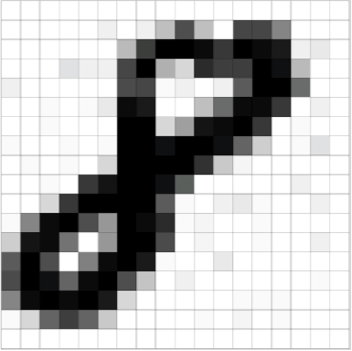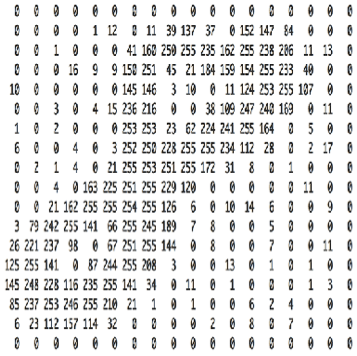
MXNet made simple: Clojure NDArray API
- 22 minsAn NDArray is an n-dimensional array that contains numerical values of identical type and size. They are called tensors. NDArrays generalize the concept of scalars, vectors and matrices.
Understanding NDArray is critical since it is the data structure that will be used to perform neural network operations. A Neural Network is nothing more than a function that takes in NDArrays and returns NDArrays performing some tensor computations that will be described in a following post. In this post, I will walk you through how we can create NDArrays and perform simple operations on them using Clojure MXNet.
NeuralNetwork :: [NDArray] -> [NDArray]
Notes
Apache MXNet is a open-source Deep Learning framework that is an alternative to Google’s Tensorflow. A Neural Network is a description of how tensors flow!
If you are familiar with Python, the numpy library provides a very similar abstraction.
Before we begin…
We will need to import certain packages:
(require '[org.apache.clojure-mxnet.ndarray :as ndarray])
(require '[org.apache.clojure-mxnet.dtype :as d])
Basic Operations
Creation
With specific values
;; Create an `ndarray` with content set to a specific value
(def a (ndarray/array [1 2 3 4 5 6] [2 3]))
;; Getting the shape as a Clojure vector
(ndarray/shape-vec a) ;[2 3]
;; Visualizing the ndarray as a Clojure vector
(ndarray/->vec a) ;[1.0 2.0 3.0 4.0 5.0 6.0]
With 0s or 1s values
(let [b (ndarray/zeros [2 5])
c (ndarray/ones [1 3 24 24])]
(println (ndarray/shape-vec b)) ;[2 5]
(println (ndarray/->vec b)) ;[0.0 0.0 0.0 0.0 0.0 0.0 0.0 0.0 0.0 0.0]
(println (ndarray/shape-vec c)) ;[1 3 24 24]
(println (ndarray/->vec c)) ;[1.0 1.0 ... 1.0]
)
Set NDArray Type
An NDArray holds 32-bit floats by default
(def a (ndarray/array [1 2 3 4 5 6] [2 3]))
;; Getting the dtype
(ndarray/dtype a) ;#object[scala.Enumeration$Val 0x781578fc "float32"]
Its type can be change to another numeric type
(let [b (ndarray/as-type a d/INT32)]
(println (ndarray/dtype b)) ;#object[scala.Enumeration$Val 0x7364f96f int32]
(println (ndarray/->vec b)) ;[1.0 2.0 3.0 4.0 5.0 6.0]
)
Here is the list of dtypes available in MXNet:
UINT8INT32FLOAT16FLOAT32FLOAT64
Tensor Operations
MXNet supports a lot of tensor operations. Only a few will be discussed in this post. You can look at the NDArray API reference when needed.
Arithmetic Operations
All the basic arithmetic operations you know are available on NDArrays: +, -, *, \, etc.
(let [b (ndarray/ones [1 5])
c (ndarray/zeros [1 5])]
(println (ndarray/->vec (ndarray/+ b c))) ;[1.0 1.0 1.0 1.0 1.0]
(println (ndarray/->vec (ndarray/* b c))) ;[0.0 0.0 0.0 0.0 0.0]
)
Slice Operations
Slicing NDArrays is really useful in the case of images. For instance, we could slice the red pixel values from the NDArray representing an RGB image.
;; Slice Operations
(let [b (ndarray/array (range 1 (inc (* 3 2 2))) [3 2 2]) ; Pretend b is an RGB image of size 2x2
b0 (ndarray/slice b 0) ;; Retrieving the red pixel values
b1 (ndarray/slice b 1) ;; Retrieving the green pixel values
b2 (ndarray/slice b 1 3)] ;; Retrieving the green and blue pixel values
(println (ndarray/->vec b0)) ;[1.0 2.0 3.0 4.0]
(println (ndarray/shape-vec b0)) ;[1 2 2]
(println (ndarray/->vec b1)) ;[5.0 6.0 7.0 8.0]
(println (ndarray/shape-vec b1)) ;[1 2 2]
(println (ndarray/->vec b2)) ;[5.0 6.0 7.0 8.0 9.0 10.0 11.0 12.0]
(println (ndarray/shape-vec b2)) ;[2 2 2]
)
Transposition
Transposing NDArrays in an efficient way is important when carrying out matrix operations in a Neural Network
(let [at (ndarray/transpose a)]
(println (ndarray/shape-vec a)) ;[2 3]
(println (ndarray/shape-vec at)) ;[3 2]
)
Dot Product
The famous Dot Product is also available for NDArrays. Very useful when designing evaluation metrics for instance.
(let [b (ndarray/transpose a)
c (ndarray/dot a b)
d (ndarray/dot b a)]
(println (ndarray/->vec c)) ;[14.0 32.0 32.0 77.0]
(println (ndarray/shape-vec c)) ;[2 2]
(println (ndarray/->vec d)) ;[17.0 22.0 27.0 22.0 29.0 36.0 27.0 36.0 45.0]
(println (ndarray/shape-vec d)) ;[3 3]
)
Random Initialization
A very important idea in Machine Learning is randomness. We will see later on that we need to randomly initialize some parameters in the models before training them.
(let [u (ndarray/uniform 0 1 (mx-shape/->shape [2 2]))
g (ndarray/normal 0 1 (mx-shape/->shape [2 2]))]
;; Uniform Distribution
(println (ndarray/shape-vec u)) ;[2 2]
(println (ndarray/->vec u)) ;[0.94374806 0.9025985 0.6818203 0.44994998]
;; Gaussian Distribution
(println (ndarray/shape-vec g)) ;[2 2]
(println (ndarray/->vec g)) ;[1.2662556 0.8950642 -0.6015945 1.2040559]
)
MXNet also provides a namespace named random containing the following probability distributions to initialize NDArrays
(require '[org.apache.clojure-mxnet.random :as random])
;; Initializing random ndarrays with `random`
(let [u (random/uniform 0 1 [2 2])
g (random/normal 0 1 [2 2])]
;; Uniform Distribution
(println (ndarray/shape-vec u)) ;[2 2]
(println (ndarray/->vec u)) ;[0.94374806 0.9025985 0.6818203 0.44994998]
;; Gaussian Distribution
(println (ndarray/shape-vec g)) ;[2 2]
(println (ndarray/->vec g)) ;[1.2662556 0.8950642 -0.6015945 1.2040559]
)
Data Processing
Machine Learning Models are trained on images, texts, videos, etc. The data needs to be converted into NDArrays for the models to use it. This processing step is necessary to train the models and make new predictions.
The next section will detail how one would do it with images.
MNIST Dataset
The MNIST database is a large database of handwritten digits that is used to train machine learning systems. One image digit from this database is shown below

This digit is a 2-dimensional vector containing pixel values in the range [0, 255]. This is how grayscale images are stored.

An image from this Dataset can easily be converted into an NDArray and then used by the models. MXNet provides an image namespace for loading image data into NDArrays.
(require '[org.apache.clojure-mxnet.image :as mx-img])
;;; Loading Data as NDArrays
(let [img-filename "images/mnist_digit_8.jpg" ;; MNIST digit 8 sample
img-grayscale-nd (mx-img/read-image img-filename {:color-flag 0})
img-color-nd (mx-img/read-image img-filename {:color-flag 1})]
;; Grayscale image
(println (ndarray/shape-vec img-grayscale-nd)) ;[28 28 1]
(println (ndarray/dtype img-grayscale-nd)) ;#object[scala.Enumeration$Val 0x328889c6 uint8]
;; Color Image
(println (ndarray/shape-vec img-color-nd)) ;[28 28 3]
(println (ndarray/dtype img-color-nd)) ;#object[scala.Enumeration$Val 0x328889c6 uint8]
)
The code above demonstrates how to read images from disk and turn them into NDArrays. The color-flag parameter in the mx-img/read-image function tells MXNet to load either the image in grayscale (only one channel) or with colors (three channels).
Under the hood, MXNet uses OpenCV to read images from disk. One can directly use OpenCV to do it
(require '[opencv4.core :as cv])
(require '[opencv4.utils :as cvu])
;; With OpenCV
(let [img-filename "images/mnist_digit_8.jpg" ;; MNIST digit 8 sample
img-grayscale-nd (-> img-filename
(cv/imread cv/COLOR_BGR2GRAY)
cvu/mat->flat-rgb-array
(ndarray/array [28 28 1]))
img-color-nd (-> img-filename
cv/imread
cvu/mat->flat-rgb-array
(ndarray/array [28 28 3]))]
;; Grayscale Image
(println (ndarray/shape-vec img-grayscale-nd)) ;[28 28 1]
(println (ndarray/dtype img-grayscale-nd)) ;#object[scala.Enumeration$Val 0x328889c6 float]
;; Color Image
(println (ndarray/shape-vec img-color-nd)) ;[28 28 3]
(println (ndarray/dtype img-color-nd)) ;#object[scala.Enumeration$Val 0x328889c6 uint8]
)
Conclusion
NDArrays are the core data-structures used in MXNet. Understanding what they are and what one can do with them is fundamental.
Being able to transform your raw data (images, text, videos, …) into NDArray is an important skill because everything that will flow into your models will be NDArrays.
This post should give you the necessary background needed to understand symbolic computations that will be covered in the next post.
References and Resources
- MXNet Website
- Tensorflow Website
- Numpy Website
- NDArray API Reference
- MXNet official NDArray API tutorial
- MXNet Github Repo
- An introduction to the MXNet API — part 1
Here is also the code used in this post - also available in this repository
(ns mxnet-clj-tutorials.ndarray
"Tutorial for `ndarray` manipulations"
(:require
[org.apache.clojure-mxnet.dtype :as d]
[org.apache.clojure-mxnet.ndarray :as ndarray]
[org.apache.clojure-mxnet.image :as mx-img]
[org.apache.clojure-mxnet.random :as random]
[org.apache.clojure-mxnet.shape :as mx-shape]
[opencv4.core :as cv]
[opencv4.utils :as cvu]))
;; Create an `ndarray` with content set to a specific value
(def a
(ndarray/array [1 2 3 4 5 6] [2 3]))
;; Getting the dtype
(ndarray/dtype a) ;#object[scala.Enumeration$Val 0x781578fc "float32"]
;; Getting the shape as a clojure vector
(ndarray/shape-vec a) ;[2 3]
;; Visualizing the ndarray as a Clojure vector
(ndarray/->vec a) ;[1.0 2.0 3.0 4.0 5.0 6.0]
;; Ndarray creations
(let [b (ndarray/zeros [2 5])
c (ndarray/ones [1 3 24 24])]
(println (ndarray/dtype b)) ;#object[scala.Enumeration$Val 0x781578fc float32]
(println (ndarray/shape-vec b)) ;[2 5]
(println (ndarray/->vec b)) ;[0.0 0.0 0.0 0.0 0.0 0.0 0.0 0.0 0.0 0.0]
(println (ndarray/dtype c)) ;#object[scala.Enumeration$Val 0x781578fc float32]
(println (ndarray/shape-vec c)) ;[1 3 24 24]
(println (ndarray/->vec c)) ;[1.0 1.0 ... 1.0]
)
;; Cast to another dtype
(let [b (ndarray/as-type a d/INT32)]
(println (ndarray/dtype b)) ;#object[scala.Enumeration$Val 0x7364f96f int32]
(println (ndarray/->vec b)) ;[1.0 2.0 3.0 4.0 5.0 6.0]
)
;; Arithmetic Operations
(let [b (ndarray/ones [1 5])
c (ndarray/zeros [1 5])]
(println (ndarray/->vec (ndarray/+ b c))) ;[1.0 1.0 1.0 1.0 1.0]
(println (ndarray/->vec (ndarray/* b c))) ;[0.0 0.0 0.0 0.0 0.0]
)
(let [b (ndarray/array (range 1 (inc (* 3 3 3))) [3 3 3])]
(ndarray/shape-vec (ndarray/slice b 1))
)
;; Slice Operations
(let [b (ndarray/array (range 1 (inc (* 3 2 2))) [3 2 2]) ; Pretend b is an RGB image of size 2x2
b0 (ndarray/slice b 0) ;; Retrieving the red pixel values
b1 (ndarray/slice b 1) ;; Retrieving the green pixel values
b2 (ndarray/slice b 1 3)] ;; Retrieving the green and blue pixel values
(println (ndarray/->vec b0)) ;[1.0 2.0 3.0 4.0]
(println (ndarray/shape-vec b0)) ;[1 2 2]
(println (ndarray/->vec b1)) ;[5.0 6.0 7.0 8.0]
(println (ndarray/shape-vec b1)) ;[1 2 2]
(println (ndarray/->vec b2)) ;[5.0 6.0 7.0 8.0 9.0 10.0 11.0 12.0]
(println (ndarray/shape-vec b2)) ;[2 2 2]
)
;; Transposition
(let [at (ndarray/transpose a)]
(println (ndarray/shape-vec a)) ;[2 3]
(println (ndarray/shape-vec at)) ;[3 2]
)
;; Matrix operations
(let [b (ndarray/transpose a)
c (ndarray/dot a b)
d (ndarray/dot b a)]
(println (ndarray/->vec c)) ;[14.0 32.0 32.0 77.0]
(println (ndarray/shape-vec c)) ;[2 2]
(println (ndarray/->vec d)) ;[17.0 22.0 27.0 22.0 29.0 36.0 27.0 36.0 45.0]
(println (ndarray/shape-vec d)) ;[3 3]
)
;; Initializing random ndarrays
(let [u (ndarray/uniform 0 1 (mx-shape/->shape [2 2]))
g (ndarray/normal 0 1 (mx-shape/->shape [2 2]))]
;; Uniform Distribution
(println (ndarray/shape-vec u)) ;[2 2]
(println (ndarray/->vec u)) ;[0.94374806 0.9025985 0.6818203 0.44994998]
;; Gaussian Distribution
(println (ndarray/shape-vec g)) ;[2 2]
(println (ndarray/->vec g)) ;[1.2662556 0.8950642 -0.6015945 1.2040559]
)
;; Initializing random ndarrays with `random`
(let [u (random/uniform 0 1 [2 2])
g (random/normal 0 1 [2 2])]
;; Uniform Distribution
(println (ndarray/shape-vec u)) ;[2 2]
(println (ndarray/->vec u)) ;[0.94374806 0.9025985 0.6818203 0.44994998]
;; Gaussian Distribution
(println (ndarray/shape-vec g)) ;[2 2]
(println (ndarray/->vec g)) ;[1.2662556 0.8950642 -0.6015945 1.2040559]
)
;;; Loading Data as NDArrays
;; With mxnet `image` API
(let [img-filename "images/mnist_digit_8.jpg" ;; MNIST digit 8 sample
img-grayscale-nd (mx-img/read-image img-filename {:color-flag 0})
img-color-nd (mx-img/read-image img-filename {:color-flag 1})]
;; Grayscale image
(println (ndarray/shape-vec img-grayscale-nd)) ;[28 28 1]
(println (ndarray/dtype img-grayscale-nd)) ;#object[scala.Enumeration$Val 0x328889c6 uint8]
;; Color Image
(println (ndarray/shape-vec img-color-nd)) ;[28 28 3]
(println (ndarray/dtype img-color-nd)) ;#object[scala.Enumeration$Val 0x328889c6 uint8]
)
;; With OpenCV
(let [img-filename "images/mnist_digit_8.jpg" ;; MNIST digit 8 sample
img-grayscale-nd (-> img-filename
(cv/imread cv/COLOR_BGR2GRAY)
cvu/mat->flat-rgb-array
(ndarray/array [28 28 1]))
img-color-nd (-> img-filename
cv/imread
cvu/mat->flat-rgb-array
(ndarray/array [28 28 3]))]
;; Grayscale Image
(println (ndarray/shape-vec img-grayscale-nd)) ;[28 28 1]
(println (ndarray/dtype img-grayscale-nd)) ;#object[scala.Enumeration$Val 0x328889c6 float]
;; Color Image
(println (ndarray/shape-vec img-color-nd)) ;[28 28 3]
(println (ndarray/dtype img-color-nd)) ;#object[scala.Enumeration$Val 0x328889c6 uint8]
)
;; Note:
;; * OpenCV default for channel ordering is `BGR`
;; * mxnet default for channel ordering is `RGB`
